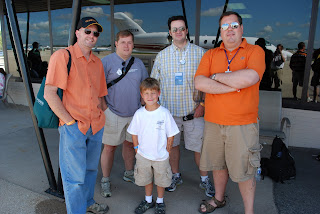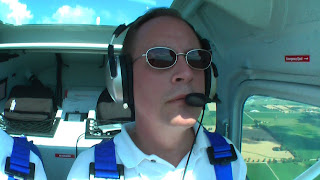
This is a regular blog post that updates listeners and viewers on events in the Airspeed world. Airspeed is an audio and video Internet media source that brings the best in aviation and aerospace to media devices and desktops everywhere. If you’re looking for the audio and video content, please check the other entries on the site. It’s all here! In the meantime, enjoy this update about what’s going on in Airspeed’s world.
California-based CFI Ron Klutts is an occasional contributor to Airspeed. He captured this story at AirVenture Oshkosh 2011.
I’ve had my eye on the Remos light sport aircraft for a while now and I finally got to go fly it at EAA AirVenture the new GX NXT model.
It was a lesson in perseverance as an airport closure and nasty weather kept us grounded for two attempts. However, the Remos team of Ryan Hernandez and Tommy Lee were patient and kept rescheduling our flight so we could accomplish this demo flight. It was worth the wait.
On our first day, I talked with Christian Majunke, head of design for the Remos GX NXT. One of the key design features was to redesign the glareshield height to allow even better visibility over the nose and to provide more legroom at the bottom of the panel. Normally, these two design goals are at odds because it squeezes the space allowed for the flight instruments. The new Dynon avionics stack reduces the panel space required and allowed the company to lower the glaresheild on the outside of the panel to dramatically increase the visibility as well as provide more legroom space for comfort.

Redesigned fresh air vents in the upper corners of the wing root provide clean and debris-free air by means of a simple design that allows the debris to continue on as the clean air changes direction to flow into the adjustable vents.

We went out to the aircraft to see the features Christian described. Being an all-composite design the lack of riveting and associated bumps and lumps was striking. As you look past the propeller, the engine cowling starts to flare out to provide a spacious interior. The composite construction allows for complex curves to make a comfortable and roomy interior that you don’t expect in a two-place aircraft. Nice straight lines on trailing edges and even gaps between control surfaces shows their attention to detail.
Christian explained that the tapering aft of the fuselage allowed for reduced weight and drag reduction made possible by the composite construction. He described the aircraft is rated for +4/-2 Gs and, if it’s under a 1,000 lbs., then it becomes +5/-3 Gs. It has a 100-knot cruising speed at a conservative 5 gph fuel flow so, with the 21 gallons on board, it gill give 3.5 hours of cruise with VFR reserve.

The demo aircraft was equipped with two Dynon SkyView displays and a Garmin 696 in the center panel, providing airport diagrams on the ground and a wealth of airport information on the large display.
The center stick appeals to me. It just seems like the right way to control an airplane. The aircraft has dual linked throttles, so the pilot in the left seat can use either left or right hand on the stick and then the other hand can use either left or right mounted throttle. Thus, the aircraft accommodates both pilots who are accustomed to the traditional control configuration of stick-flown aircraft while those who might be more comfortable with a yoke and the left-handedness that that engenders will also find the controls intuitive.
The GX NXT accelerates quickly and Ryan allowed me to perform the takeoff after the photo ship departed. The controls were light but not touchy. It was a brisk climb of 700 FPM despite the mid afternoon departure and warm temps. The Rotax 912 engine started instantly was very smooth despite the RPMs being twice what I’m used to from the engines behind which I typically fly.
Fully articulating tinted sun visors allow the operator to position them horizontally or vertically with ease to reduce sun glare to increase comfort and viewing pleasure.
The Remos features nose wheel steering and a single push lever seen angling up between the seats that activates both brakes. It’s very intuitive to use and is a nice change from differential braking.

Ryan showed me the various ways the PFD can be configured to emphasis more on the attitude instruments or engine parameters based on the user preference and flight regime. That’s just one of the advantages of the Dynon system. The integrated EFIS and EMS displays along with the transponder reduces panel space as it’s all in a single unit.
Our patience paid off on the third day as we had near-cloudless skies in which to shoot air-to-air. Ryan explained that the doors can be removed for even better visibility to enjoy the open air aspect. I preferred the doors on but still enjoyed an amazing view out my door as the plexiglass extends very low and makes for an incredible view.
The Remos GX NXT showed exceptional handling and was an ease to fly and land. Most importantly, it was fun and enjoyable to fly and we need more of that in general aviation to attract and keep pilots flying. If I continued talking to Tommy I think he would have sold me a plane as he made a great case for the economics of it being on a leaseback. Something worth considering so more people can have the opportunity to rent it and enjoy this fun flying machine.
Afte the flight, I asked Christian what feature they left off the plane due to time constraints or any other reason that something would have to be left off to include in the next version. His answer? An Espresso machine, Barrista not included though…. Now that would be a great way to travel.
There’s more information about the Remos GX NXT at www.remos.com.
Story by Ron Klutts









